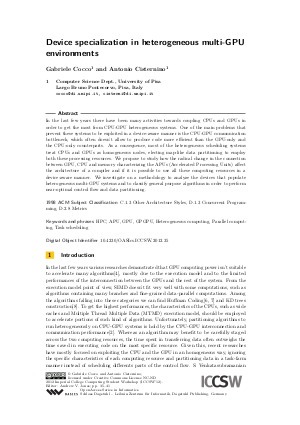Device specialization in heterogeneous multi-GPU environments
Authors Gabriele Cocco, Antonio Cisternino
-
Part of:
Volume:
2012 Imperial College Computing Student Workshop (ICCSW 2012)
Part of: Series: Open Access Series in Informatics (OASIcs) - License:
 Creative Commons Attribution-NonCommercial-NoDerivs 3.0 Unported license
Creative Commons Attribution-NonCommercial-NoDerivs 3.0 Unported license
- Publication Date: 2012-11-09
File

PDF
OASIcs.ICCSW.2012.35.pdf
- Filesize: 0.68 MB
- 7 pages
Document Identifiers
Subject Classification
Keywords
- HPC APU GPU GPGPU Heterogeneous-computing Parallel-computing Task-scheduling
Metrics
- Access Statistics
-
Total Accesses (updated on a weekly basis)
0PDF Downloads0Metadata Views
Abstract
In the last few years there have been many activities towards coupling CPUs and GPUs in order to get the most from CPU-GPU heterogeneous systems. One of the main problems that prevent these systems to be exploited in a device-aware manner is the CPU-GPU communication bottleneck, which often doesn't allow to produce code more efficient than the GPU-only and the CPU-only counterparts. As a consequence, most of the heterogeneous scheduling systems treat CPUs and GPUs as homogeneous nodes, electing map-like data partitioning to employ both these processing resources. We propose to study how the radical change in the connection between GPU, CPU and memory characterizing the APUs (Accelerated Processing Units) affect the architecture of a compiler and if it is possible to use all these computing resources in a device-aware manner. We investigate on a methodology to analyze the devices that populate heterogeneous multi-GPU systems and to classify general purpose algorithms in order to perform near-optimal control flow and data partitioning.
Cite As Get BibTex
Gabriele Cocco and Antonio Cisternino. Device specialization in heterogeneous multi-GPU environments. In 2012 Imperial College Computing Student Workshop. Open Access Series in Informatics (OASIcs), Volume 28, pp. 35-41, Schloss Dagstuhl – Leibniz-Zentrum für Informatik (2012)
https://doi.org/10.4230/OASIcs.ICCSW.2012.35
BibTex
@InProceedings{cocco_et_al:OASIcs.ICCSW.2012.35,
author = {Cocco, Gabriele and Cisternino, Antonio},
title = {{Device specialization in heterogeneous multi-GPU environments}},
booktitle = {2012 Imperial College Computing Student Workshop},
pages = {35--41},
series = {Open Access Series in Informatics (OASIcs)},
ISBN = {978-3-939897-48-4},
ISSN = {2190-6807},
year = {2012},
volume = {28},
editor = {Jones, Andrew V.},
publisher = {Schloss Dagstuhl -- Leibniz-Zentrum f{\"u}r Informatik},
address = {Dagstuhl, Germany},
URL = {https://drops.dagstuhl.de/entities/document/10.4230/OASIcs.ICCSW.2012.35},
URN = {urn:nbn:de:0030-drops-37623},
doi = {10.4230/OASIcs.ICCSW.2012.35},
annote = {Keywords: HPC APU GPU GPGPU Heterogeneous-computing Parallel-computing Task-scheduling}
}
